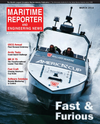
Page 58: of Maritime Reporter Magazine (March 2014)
U.S. Coast Guard Annual
Read this page in Pdf, Flash or Html5 edition of March 2014 Maritime Reporter Magazine
58 Maritime Reporter & Engineering News • MARCH 2014
ClassNK Updates Safety Guide- lines for Gas Fuelled Ships
ClassNK released its second version of the Guide- lines for Gas Fuelled Ships, an updated version refl ects the requirements for the design of natural gas fuelled ships based on the outcome of discus- sions held at IMO regarding the International Code of Safety for ships using gases or other low fl ash- point fuels (IGF Code). With regulations curbing at- mospheric pollution and greenhouse gas emissions growing stricter amid stronger calls for a greener shipping industry, the industry is turning towards the use of natural gas as a potential cleaner alternative to liquid fuel oil. Expected reductions in gas prices due to the recent development of non-conventional energy resources such as shale gas has also led to an increase in gas fuelled ship newbuildings and proj- ects. These guidelines are available free of charge via the ClassNK website for those who have regis- tered for the ClassNK “My Page” service. www.classnk.com
Xfl ow Watermist from Wil- helmsen Technical Solutions
Wilhelmsen Technical Solutions’ patented Unitor
XFlow low pressure water mist fi re fi ghting sys- tems is being installed for two leading Norwegian shipowners. The contract includes a total fl ooding water mist system for the ship’s engine room and a local protection water mist system. The system cov- ers with a penetrating mist that extinguishes fi res quickly, with compact design and low water con- sumption and power demand. www.wilhelmsen.com/technicalsolutions
Omega Debuts New Transmitters
Omega introduced new po- tentiometer input to DC trans- mitters with the launch of the
DMD4008 series of transmit- ters accepts a resistance input from potentiometer, slidewire, linear position, displacement or rotational devices and provides an optically isolated DC voltage or current output that is linearly related to the potentiometer po- sition. The DMD4008 is a quick setup for hundreds of I/O ranges, features external switches and table for range selection. Applications include over, under, out-of-range position monitoring, remote control of position monitoring, remote control of positioning devices and simplify control of potentiometer out- puts. Industries include automotive, chemical and general manufacturing. Pricing starts at $299. www.omega.com
Engine Room Fires: Lessons Learned “Lessons are still not being learned when it comes to preventing engine room fi res.” This is the message from Graeme Temple, Regional Director for Braemar SA’s Far East operations, following a review of incidents tak- ing place in 2013.
At any one time in a modern engine room there can be thousands of liters of fl ammable liquids circulating inside the pipe systems. Aside from the obvious risk to life, a ship fi re is inevitably a very expensive, time consum- ing, property repair. Heat damage, fi refi ghting effort damage, acid residues from burnt plastics, soot cleaning and painting all add up, leaving a cost which is extremely hard to control for all involved.
According to IACS rules and after 1998, also SOLAS Ch II-2 Reg.15.2.10, all surfaces above 220oc must be insulated or protected in order to prevent ignition of fl ammable fl uids. However, there appears to be a continuing ne- glect of areas where fl ammable liquids can escape from high pressure (HP) and LP (low pressure) fuel, HP and LP lubricating, purifi er and fuel valve cooling systems. “In reality basic maintenance is all that is required. Engine room crew should carry out regular inspection of pipes and associated fi ttings; they should refi t brackets and lagging when carrying out maintenance; leaks should be repaired quickly be- fore a drip becomes a spray; spares for HP fuel pipes should be available, and leakage alarm systems should be tested regularly. Prevention is as straightforward as that.” www.braemarsa.com
Helicopter Refueling Systems
DGI is now supplying a full range of Helicopter Refueling Systems for the EMEA region. Wil- max is a leader in the Asia Pacifi c for Helicopter Refueling Systems. Started in 1999 with the design and manufacturing of HRS they have now supplied more than 250 systems world-wide.
DGI/Wilmax has developed its own line of Helicopter Refueling Systems under the brand name “heliRFS.” As an engineering company DGI/Wilmax tailors all of the systems to meet client’s requirements.
Designing and manufacturing helicopter refueling systems for use in harsh environments is a challenging business. One need to meet high demands for safety and reliability. DGI/Wil- max specializes in the design and manufacturing of helicopter refueling systems, transportable tanks for hazardous cargo, and providing services in the fi eld of inspection, maintenance, over- haul, repair and recertifi cation of the systems.
The DGI/Wilmax Helicopter Refueling Systems can be tailor-made to all relevant require- ments, such as CAP 437, the OLF helideck manual, the Norwegian Maritime Directorate,
ASME U-Stamp and Brazil’s NR-13 Regulations.
A heliRFS typically consists of a Dispenser Skid, Pump Skid and a Transportable Aviation
Fuel Tank, which can all be made from either Carbon or Stainless steel. However, the scope of possibilities is not limited to these and DGI/WIlmax regularly provide clients with Laydown Skids, Deluge Systems, lifting gear, Static Storage Tanks, Remote Control Panels and any other requested equipment. www.dgi-company.com
NEW PRODUCTS: FIRE DETECTION & PREVENTION
MR #3 (50-58).indd 58 3/4/2014 11:46:29 AM

 57
57

 59
59
